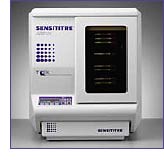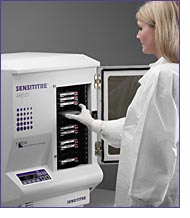| |
By Dr. Kirk Doing, Eastern Maine Healthcare, Affiliated Laboratory, Inc.,
Bangor, Maine
 Susceptibility studies remain among the most important functions performed in the clinical microbiology
laboratory; however, mounting resistance, coupled with sometimes novel mechanisms, continue to challenge the ability of commercial
Antimicrobial Susceptibility Testing (AST) systems to accurately detect some resistant phenotypes. Indeed, for some organisms, microdilution
methods with full 18-24 hours of incubation yield the most accurate phenotypic results. This has forced many laboratories to maintain
multiple AST methodologies to generate reliable results for different clinical isolates, which adds cost to overall laboratory operations. Susceptibility studies remain among the most important functions performed in the clinical microbiology
laboratory; however, mounting resistance, coupled with sometimes novel mechanisms, continue to challenge the ability of commercial
Antimicrobial Susceptibility Testing (AST) systems to accurately detect some resistant phenotypes. Indeed, for some organisms, microdilution
methods with full 18-24 hours of incubation yield the most accurate phenotypic results. This has forced many laboratories to maintain
multiple AST methodologies to generate reliable results for different clinical isolates, which adds cost to overall laboratory operations.
 The Sensititre ARIS 2X System has been designed to incubate and
then auto-read Sensititre microdilution susceptibility
and identification plates. Sixty-four plates can be incubated in each ARIS 2X instrument, with
up to four modules (256 plate capacity) being linked to a single computer.
Inventory is tracked using barcode information present on each plate. A temperature
controlled, and timed incubation is maintained within the instrument, after which, robotics are
used to transport plates to the reading unit. Hydrolysis of a fluorogenic substrate by the bacterial
isolate is used to measure growth in each well and determine MIC endpoints. Appealing features
of Sensititre plates include a traditional doubling dilution format, a large selection of antimicrobics,
and the ability to test both fastidious and non-fastidious bacteria using a single AST system. The Sensititre ARIS 2X System has been designed to incubate and
then auto-read Sensititre microdilution susceptibility
and identification plates. Sixty-four plates can be incubated in each ARIS 2X instrument, with
up to four modules (256 plate capacity) being linked to a single computer.
Inventory is tracked using barcode information present on each plate. A temperature
controlled, and timed incubation is maintained within the instrument, after which, robotics are
used to transport plates to the reading unit. Hydrolysis of a fluorogenic substrate by the bacterial
isolate is used to measure growth in each well and determine MIC endpoints. Appealing features
of Sensititre plates include a traditional doubling dilution format, a large selection of antimicrobics,
and the ability to test both fastidious and non-fastidious bacteria using a single AST system.
The Sensititre ARIS 2X System was developed in the 1980s, however, its widespread use in the
clinical arena has been limited. Improved plate design, instrumentation, and data management
software support the need for direct comparisons of the ARIS 2X to other available instrumentsand AST methods.
This study focused on verifying the accuracy of Sensititre MIC trays incubated and read
automatically by the ARIS 2X for a variety of clinical isolates. Susceptibility
results were compared to those obtained with either the Vitek Legacy (bioMerieux, Marcy
L’Etoile, France), Pasco frozen microdilution panels (Becton Dickinson, Sparks, MD), the
E-test gradient diffusion method (AB Biodisk, Solna, Sweden), or combinations of these
methods for 401 clinical isolates comprising multiple genera and antimicrobial resistant
patterns. Gram-negative identifications were evaluated using Sensititre GNID panels. The
ability to consolidate multiple AST methods currently used in our laboratory onto the ARIS
2X platform was also explored.
 A total of 401 clinical isolates were tested against clinically appropriate antibiotics. Bacterial isolates included a “defined” collection
of 318 strains (200 gram-negative and 118 gram-positive) collected up to 90 days prior to the start of the study. These isolates were maintained
frozen at -70°C until testing, and were selected for species diversity and phenotypic resistant patterns. An additional 83 (69 gram-negative and 14
gram-positive) organisms were tested concurrently with the Vitek Legacy. No duplicate isolates were tested. A total of 401 clinical isolates were tested against clinically appropriate antibiotics. Bacterial isolates included a “defined” collection
of 318 strains (200 gram-negative and 118 gram-positive) collected up to 90 days prior to the start of the study. These isolates were maintained
frozen at -70°C until testing, and were selected for species diversity and phenotypic resistant patterns. An additional 83 (69 gram-negative and 14
gram-positive) organisms were tested concurrently with the Vitek Legacy. No duplicate isolates were tested.
Identifications using Sensititre GNID plates were compared with those obtained using Vitek GNI
Plus cards (V1311) for 205 gram-negative isolates. Discrepant identifications
were settled using an additional commercial identification kit, Crystal ID (Becton Dickinson), API 20 NE strips (bioMerieux), and/or conventional
tubed biochemical media (Remel, Inc). Isolates included both
patient and laboratory stock cultures.
An essential agreement
of 98%, after discrepant
analysis, was obtained
between the ARIS 2X
and the AST methods
evaluated. Categorical
error rates obtained with
the ARIS 2X were within
accepted limits, and a
very major error rate of <1.5%, was similar to
recent studies evaluating
the Sensititre ARIS 2X
and MicroScan System.
The Sensititre® ARIS
2X® System provides an
excellent platform to consolidate
microbiology test
methods:
Consolidation
Currently many laboratories
are forced to maintain
multiple AST methods
in order to accurately
detect antibiotic resistance
expressed by the
multiple bacterial genera
encountered in the clinical
setting. An attractive
feature of the Sensititre
ARIS 2X system is the
potential to consolidate
susceptibility testing onto
a single platform. In the
current study, all susceptibility
studies, including
those for fastidious organisms,
were completed
on the ARIS 2X using just
three different susceptibility
plates.
Streamline Set-Up
Inoculation and incubation
procedures are basically
the same for all
Sensititre plates further
streamlining workflow. In
contrast, three separate
Vitek cards, three different
Pasco panel configurations,
and multiple Etest
strips were necessary to complete the
same work. Adapting to
an 18-24 hour incubation
time for susceptibilities
may also seem problematic,
given data that supports
improved patient
outcome when rapid susceptibility
results are
made available to clinicians.
However, rapid
phenotypic susceptibility
testing of gram-positive
organisms presents problems,
and may not accurately
detect beta-lactam
or glycopeptide resistance.
While combining
genotypic and phenotypic
susceptibility methods
help in addressing this
issue, at present, phenotypic
susceptibility studies
for gram-positive cocci
require a full 24 hours of
incubation.
Flexible Test Formats
The 96-well microtiter
format, number of approved
antimicrobials and
testing dilutions, coupled
with automated plate inoculation
procedures lend
flexibility to the system
and create the potential
for unique enhancements
to Sensititre plate design.
Reliable System
Unlike Vitek cards, Sensititre
plates can be incubated
off-line and read
visually with results entered
directly into the
data management software
for report generation,
computer interface
transmission, and statistical
archiving; this virtually
eliminates instrument
down-time.
This study was performed
to verify the performance of the ARIS 2X Automated
Susceptibility and
Identification System for
routine use in the clinical
microbiology laboratory.
The Sensititre ARIS 2X
System performed well,
and offers a reliable and
accurate means to perform
routine susceptibility
testing of rapidly growing
bacteria frequently encountered
in the clinical
laboratory. The ARIS 2X
also addresses the difficulty
of maintaining multiple
AST methods in the
laboratory with the ability
to consolidate most susceptibility
testing onto a
single platform. Instrument
design, capacity,
and capability to link multiple
units to a single
computer further support
the ARIS 2X as a suitable
automated susceptibility
and identification system
worthy of consideration.
Taken from poster A-045
presented at the ASM
2006 in Orlando, FL,
Evaluation of Sensititre
Plates Read on the Automated
Incubation and Reading
System (ARIS) with
Comparison to Vitek Legacy,
Pasco Frozen Microdilution
Panels, and E-test
Strips for Determining Susceptibility
Profiles of Commonly Encountered Bacteria,
K. M. Doing and E.C.
Rioux, Eastern Maine
Healthcare, Affiliated Laboratory,
Inc., Bangor, Maine
04401.
|
 |



